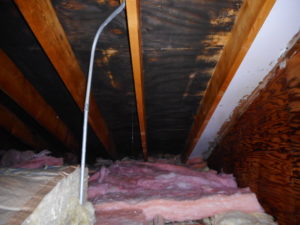 One of the key factors in mold growth is ventilation.
One of the key factors in mold growth is ventilation.
Good ventilation helps circulate new, clean air and helps it move throughout the area and prevents allergens from spreading.
Areas with poor ventilation can become breeding grounds for mold if they have a wet area to feed on and that is something you definitely want to avoid.
Sometimes it’s tough to really determine if you have poor ventilation so we’ve got some tips to help you out.
How Do You Know If You Have Poor Ventilation?
Obviously, if you find mold in your home, that can be a big indicator of poor ventilation, but that isn’t the only sign. (Plus, our goal is to AVOID mold growth so we want to discover inadequate ventilation before that happens.)
Have you ever noticed your glass windows and shower doors having a frosted look to them? It’s not something most people commonly look out for but it can be a sign the air in your home isn’t circulating well. (Me? I have a super bizarre reaction to frosted glass. I can’t touch it or see anyone else touch it. Ick. I would definitely notice this.)
Another sign would be the appearance of rust staining on metal pipes. Poor ventilation can lead to a lot of humidity and that condensation can build up on the metal. Adding moisture to metal will usually result in rusting.
This leads to the next sign which is hot or cold spots. When you have poor ventilation you are more likely to have noticeable changes in temperature between rooms in the same home. If you find areas of your home to be stuffy and warm, even when they shouldn’t be, you might have some ventilation issues.
Poor Ventilation and Mold Growth
Unfortunately, like I said, poor ventilation can lead to mold growth and that is what we all want to avoid.
When you’re living in a home with poor ventilation, the lack of air circulation can cause humidity to build up from the heat. Humidity leads to condensation and condensation leads to a perfect spot for mold to set up shop.
If you aren’t sure what to look for regarding mold growth in your home, we’ve got lots of information here, so definitely check that out.
What Causes Poor Ventilation?
When it comes to ventilation, having exterior vents in your house is key. This allows for air inside your house to be pulled out while drawing fresh air inside. If you don’t have enough vents inside your house, the amount of pollutants inside are going to build up and that’s not good.
If you do have exterior vents, make sure they aren’t obstructed. Debris can build up and that’s going to clog your air flow. Your dryer vents are a biggie. They can easily get clogged up with lint and dust so keep an eye out for that.
Make sure your interior HVAC vents are all open and clear of obstruction. Air intakes are usually found higher up on walls, while the vents where your air conditioning/heat enter the room are on the floor. Furniture is the most common obstruction to interior HVAC vents. Make sure you leave a gap for airflow between furniture and your HVAC vents.
Need a Professional?
There can be a few factors contributing to mold growth in your home, so it’s important to know what to look for. If you’d like a professional to take a look, we’d be more than happy to help you out. Since mold is what we do we can answer any questions you might have. Feel free to contact us today!







